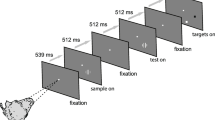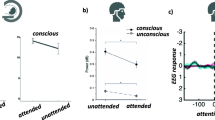Summary
The evidence is reviewed which indicates that the flicker fusion frequency is determined centrally rather than in the eye.
The sequence in the cortex of facilitation, inhibition and supranormality after a flash delivered to the eye is described as it is evidenced both in summed and in single unit responses. Inhibition after a flash is more prolonged than after optic nerve stimulation; the difference probably accounts for the discrepancy between the refractory period of single cortical units when tested by paired flashes and by paired stimuli to the optic nerve, and thus accounts for the discrepancy between flicker fusion frequency and the refractory period of neurones.
Facilitation of the response of single cortical units to a light flash, by simultaneous stimulation of the optic nerve is described and it is suggested that this mechanism may account for the increase in critical fusion frequency (CFF) when light and electrical pulses are delivered to the eye simultaneously; the time course of facilitation suggests mediation via subcortical centers and the evidence is reviewed which suggests that they may increase the CFF in intact animals and humans.
Résumé
Plusieurs raisons sont résumées qui indiquent que la fréquence critique de flicker est déterminée à un niveau central plutôt que dans l'oeil même.
Les réponses corticales globales et d'unités corticales évoquées par stimulation des éclairs ont été analysées par rapport aux périodes de facilitation, inhibition et supranormalité. Un éclair est suivi d'une inhibition de plus longue durée comparée à celle qui suit une stimulation électrique du nerf optique; la différence explique probablement la différence entre la période réfractaire des neurones corticales au cas de stimulation par éclairs et au cas de stimulation du nerf optique et la différence entre la fréquence critique de flicker et la période réfractaire neuronale.
La stimulation simultanée de l'oeil par éclairs et du nerf optique donne lieu à une facilitation des réponses solitaires aux éclairs. Le méchanisme peut expliquer l'augmentation de la fréquence critique de flicker au cas de stimulation simultanée électrique et lumineuse de la rétine. La latence de facilitation indique probablement une participation des centres subcorticales à ce phénomène, qui augmente probablement la fréquence critique de flicker chez le singe et l'homme.
Zusammenfassung
Eine Reihe von Befunden deuten daraufhin, dass die Flimmerfusions-frequenz von zentralen Faktoren und nicht von der Retina bestimmt wird.
Der Erregbarkeitscyklus der Hirnrinde, wie er sich im summierten Potential und im Potential einzelner Einheiten nach Lichtblitzen zeigt, die das Auge treffen, besteht in Facilitierung, Hemmung und Supranormalität. Die Periode der Hemmung nach einem Lichtblitz ist länger als nach elektrischer Reizung des Nervus Opticus. Dieser Unterschied kann wahrscheinlich die längere Refraktärperiode der durch Lichtreize ausgelösten Potentiale als der durch elektrische Reize des Nervus Opticus hervor-gerufenen Potentiale erklären und gleichzeitig den Unterschied zwischen der Flimmerfusionsfrequenz und dem Refraktärstadium der kortikalen Einheiten deuten. Die Reizschwelle einer einzelnen kortikalen Einheit für retinale Reize durch Lichtblitze wird durch gleichzeitige elektrische Reizung des Nervus Opticus herabgesetzt.
Diese Facilitierung kann die Erhöhung der Flimmerfusionsfrequenz erklären, die in psychophysischen Versuchen gefunden worden ist, in denen Lichtreize gleichzeitig mit elektrischen Reizen auf das Auge einwirkten. Die Facilitierung erscheint nach einem relativ so langen Zeitinterval nach Reizung des Nervus Opticus, dass man annehmen muss, dass sie in subkortikalen Relaisstationen verzögert wird. Auch eine Reihe von psychophysischen Beobachtungen deuten daraufhin, dass subkortikale Zentren die Flimmerfusionsfrequenz beim Affen und beim Menschen erhöhen.
Similar content being viewed by others
References
Andersen, V. O. & Mosfeldt Laursen, A. (1959). Automatic Transport Device for Microelectrodes. EEG clin. Neurophysiol. 11, 172–173.
Arden, G. & Liu, Y.-M. (1960) Some Types of Response of Single Cells in the Rabbit Lateral Geniculate Body to Stimulation of the Retina by Light and to Electrical Stimulation of the Optic Nerve. Acta physiol. scand. 48, 36–48.
Battersby, W. S. (1951) The Regional Gradient of Critical Flicker Frequency after Frontal or Occipital Lobe Injury. J. exp. Psychol. 42, 59–68.
Berger, C. Personal communication.
Brindley, G. S. (1955) The Site of Electrical Excitation of the Human Eye. J. Physiol. 127, 189–200.
—, (1962) Beats Produced by Simultaneous Stinulation of the Human Eye with Intermittent Light and Intermittent or Alternating Electric Current. J. Physiol. 164, 157–167.
Brown, K. T. & Watanabe, K. (1962) Isolation and Identification of a Receptor Potential from the Pure Cone Fovea of the Monkey Retina. Nature. 193, 958–960.
Buchmann-Olsen, B. & Rosenfalck, A. M. (1957) Spectral Energy Calibration of a Light Flash Source Used in Physiological Experiments. J. opt. Soc. Amer. 47, 30–34.
Cornehls, U. (1958) Reaktionen einzelner Neurone im optischen Cortex der Katze nach elektrischen Doppelreizen des Nervus opticus. Pflügers Arch. ges. Physiol. 268, 52.
Davies, P. W. (1956) Chamber for Microelectrode Studies in the Cerebral Cortex. Science, 129, 179.
Dodt, E. (1964) Excitation and Inhibition of Single Retinal Elements in Response to Intermittent Stimulation. Docum. Ophthal. XVIII, 259–274.
Grüsser, O.-J. (1960) Receptorabhängige Potentiale der Katzenretina und ihre Reaktionen auf Flimmerlicht. Pflügers Arch. ges. Physiol. 271, 511–525.
—, & Grützner, A. (1958) Reaktionen einzelner Neurone des optischen Cortex der Katze nach elektrischen Reizserien des Nervus opticus. Arch. Psychiat. Nervenkr. 197, 405–432.
—, & Saur, G. (1960) Monoculare und binoculare Lichtreizung einzelner Neurone im Geniculatum laterale der Katze. Pflügers Arch. ges. Physiol. 271, 595–612.
Guld, C. (in press) A Glass-Covered Platinum Microelectrode. Medical Electronics and Biol. Engineering.
Ireland, F. H. (1950) A Comparison of Critical Flicker Frequencies under Conditions of Monocular and Binocular Stimulation. J. exp. Psychol. 40, 282–286.
Jung, R. (1958) Excitation, Inhibition and Coordination of Cortical Neurones. Exp. Cell. Res. Suppl. 5, 262–271.
Jung, R. (1959) Microphysiology of Cortical Neurons and its Significance for Psycho-physiology. Anal. Fac. Med., Montevideo. 44, 323–332.
Marshall, W. H. (1958) Temporal Periodicities in the Primary Projection System. Amer. J. Ophthal. 46, 99–106.
Mishkin, M. & Weiskrantz, L. (1959) Effects of Cortical Lesions in Monkeys on Critical Flicker Frequency. J. comp. Physiol. Psychol. 52, 660–666.
Perrin, F. H. (1954) A Study in Binocular Flicker. J. opt. Soc. Amer. 44, 60–69.
Sherrington, C. S. (1904) On Binocular flicker and the Correlation of Activity of Corresponding Retinal Points. Brit. J. Psychol. 1, 26–60.
Thomas, G. H. (1954) The Effect on Critical Flicker Frequency of Interocular Differences in Intensity and in Phase Relations of Flashes of Light. Amer. J. Physiol. 67, 632–646.
Veringa, F. T. H. (1964) Electro-Optical Stimulation of the Human Retina as a Research Tool. Docum. Ophthal. XVIII, 72–82.
Vernon, M. D. (1934) The Binocular Perception of Flicker. Brit. J. Psychol. 24, 351–374.
Wolbarsht, M. L., Macnichol, E. F. Jr. & Wagner, H. G. (1960) Glass Insulated Platinum Microelectrode. Science 132, 1309–1310.
Author information
Authors and Affiliations
Additional information
This investigation was supported in part by Public Health Service Research Grant NB 03943-01 from the Department of Health, Education and Welfare, National Institutes of Health, Bethesda, Md., U.S.A.
Institute of Neurophysiology, University of Copenhagen. (Director : Fritz Buchthal, M.D.).
Rights and permissions
About this article
Cite this article
Lennox-Buchthal, M.A. Single unit studies and the mechanism of flicker fusion. Doc Ophthalmol 18, 245–258 (1964). https://doi.org/10.1007/BF00160577
Issue Date:
DOI: https://doi.org/10.1007/BF00160577




